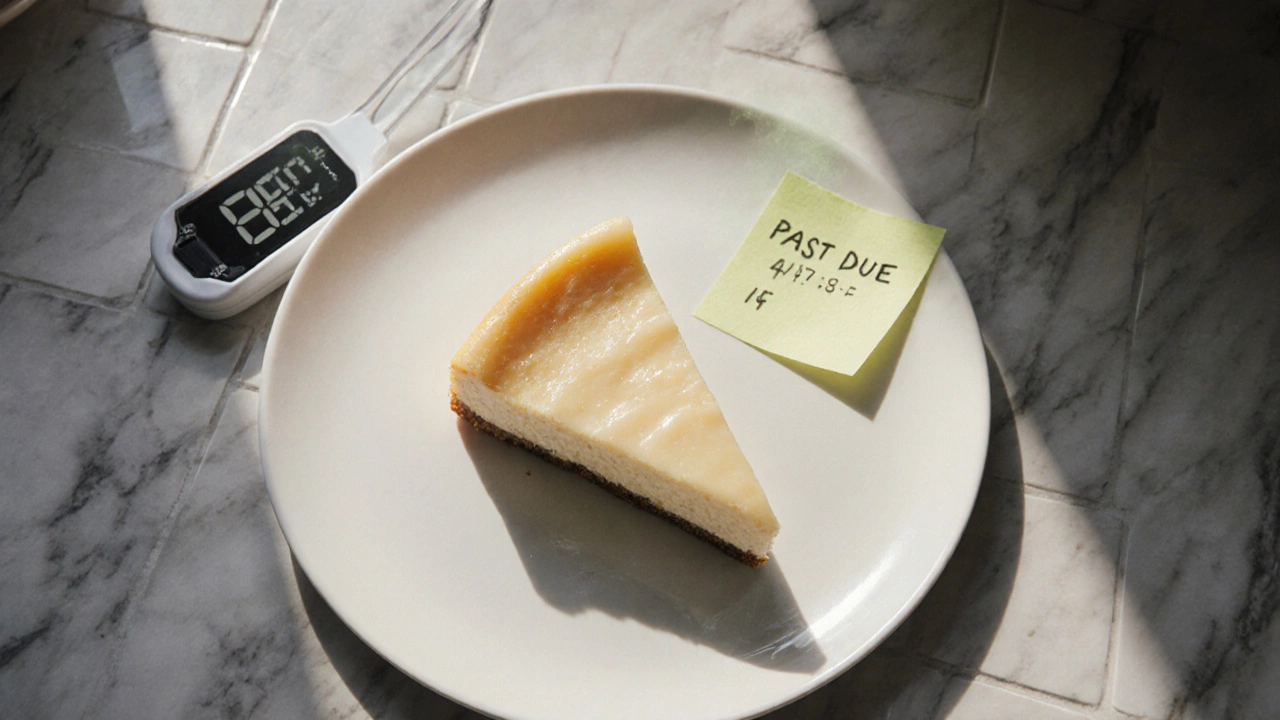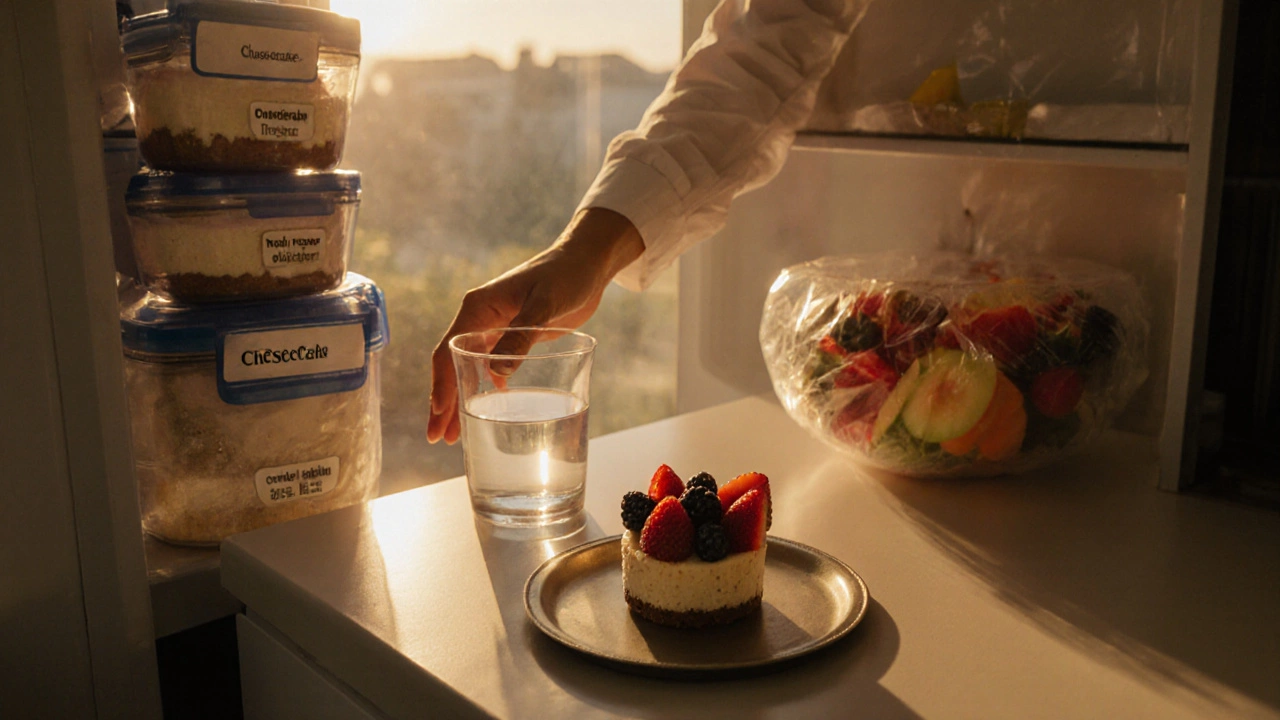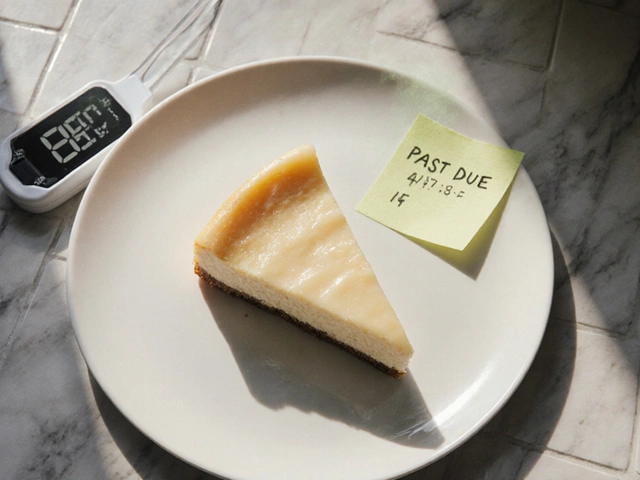
Cheesecake Safety Checker
Answer the following questions to determine if it's safe to consume your cheesecake.
Safety Assessment
If unsure, it's always safer to discard the cheesecake.
When you see a creamy slice of cheesecake is a rich dessert made from cream cheese, eggs, sugar, and a crumbly crust, often topped with fruit or chocolate, it’s tempting to dig in straight away. But there are moments when that indulgence could do more harm than good. Below we break down the real‑world scenarios where saying “no thanks” to cheesecake is the smarter move.
Food‑Safety Red Flags: Is the Cheesecake Spoiled?
Even the most loyal cheesecake fan can fall victim to food‑borne illness if the dessert isn’t stored correctly. The biggest culprits are bacterial contamination like Listeria, Salmonella, or Staphylococcus aureus. These microbes love warm, moist environments and can multiply quickly in a poorly chilled cake.
- Smell it: a sour or off‑put aroma means the dairy has broken down.
- Check the texture: watery or grainy layers often signal spoilage.
- Look at the date: most refrigerated cheesecakes keep 5‑7 days; freezer versions last 2‑3 months.
If any of these signs appear, it’s best to toss the slice. Eating a contaminated cheesecake can cause nausea, vomiting, diarrhea, and in severe cases, hospitalization.
Health Conditions That Make Cheesecake a Bad Idea
Beyond spoilage, certain medical conditions turn a classic dessert into a health hazard. Below is a quick guide to the most common scenarios.
| Condition | Why Cheesecake Is Risky | Safer Alternatives |
|---|---|---|
| Lactose intolerance | High lactose content can trigger bloating, gas, and diarrhea. | Use lactose‑free cream cheese or a dairy‑free almond‑based cheesecake. |
| Dairy allergy | IgE‑mediated reaction to milk proteins can cause hives, swelling, or anaphylaxis. | Try a soy‑ or coconut‑based version with a firm tofu filling. |
| Heart disease | Rich in saturated fat and cholesterol, which can raise LDL levels. | Opt for a reduced‑fat version using low‑fat cream cheese and a thin crust. |
| Diabetes | High sugar spikes blood glucose quickly. | Make a low‑sugar cheesecake with stevia or erythritol. |
| Pregnancy | Unpasteurized dairy or raw eggs can harbor Listeria or Salmonella, risky for the fetus. | Use pasteurized cream cheese and bake the filling thoroughly. |
| Weight management | One slice can easily exceed 400 calories. | d>Serve a mini cheesecake or a fruit‑based parfait with a light cheese layer.

Ingredient Triggers: Raw Eggs and Unpasteurized Dairy
Traditional New York‑style cheesecake calls for raw eggs and full‑fat, unpasteurized cream cheese. While the texture is silky, those ingredients can hide dangerous microbes. The Food Standards Agency advises that any recipe containing uncooked eggs should be cooked to at least 71°C (160°F) to kill Salmonella.
If you’re buying a pre‑made cheesecake from a bakery, ask whether the dairy is pasteurized and whether the batter was baked or set using a water bath. When in doubt, choose a version that has been cooked, such as a baked cheesecake or a no‑bake recipe that uses a commercial gelatin stabilizer.
Special Diets: Gluten, Vegan, and Low‑Sugar Options
People on gluten‑free or vegan diets often wonder if they can still enjoy a slice. The crust is the usual gluten culprit, typically made from graham crackers. Switch to a gluten‑free oat or almond‑flour base to keep the crunch without the wheat.
Vegan cheesecakes replace dairy with soaked cashews, tofu, or coconut cream. These alternatives naturally avoid lactose and dairy allergens, but they can be high in saturated fat if coconut is used extensively. Choose cashew‑based fillings for a better fat profile.
For a low‑sugar version, skip the confectioner’s sugar in the topping and use fresh berries. The natural sweetness of fruit often satisfies the palate while keeping the glycemic load modest.

Storing Cheesecake the Right Way
Proper storage not only preserves flavor but also prevents bacterial growth. Follow these simple rules:
- Keep refrigerated cheesecake at 4°C (40°F) or colder. Place it on a shelf rather than the door where temperature fluctuates.
- Cover tightly with plastic wrap or store in an airtight container to avoid moisture loss and odor absorption.
- If you need to keep it longer, wrap the whole cake in foil and freeze. Thaw in the fridge overnight before serving.
- Never leave a cut slice out at room temperature for more than two hours.
These steps dramatically lower the risk of cheesecake safety issues and keep the texture creamy.
When to Say “No” and What to Do Instead
Bottom line: skip the cheesecake if you’re dealing with any of the following:
- Recent gastrointestinal infection or a weakened immune system.
- Pregnancy, unless you’re certain the dessert is fully cooked and made with pasteurized ingredients.
- Diagnosed lactose intolerance, dairy allergy, or severe heart disease and you can’t modify the recipe.
- Visible signs of spoilage or an expired “use‑by” date.
Instead, reach for a fruit bowl, a low‑fat Greek yogurt parfait, or a homemade almond‑flour crust with a tofu‑based filling. You still get a creamy bite without the health gamble.
Frequently Asked Questions
Can I eat cheesecake if I have a mild lactose intolerance?
Yes, but choose a lactose‑free version or take lactase enzyme tablets. Regular cheesecake can cause uncomfortable bloating for many with even mild intolerance.
Is a no‑bake cheesecake safe for pregnant women?
Only if it’s made with pasteurized cream cheese and gelatin that has been fully set. Unpasteurized dairy poses a Listeria risk, which can harm the baby.
What’s the longest I can keep a homemade cheesecake in the fridge?
Generally 5-7 days. After that, the risk of spoilage and bacterial growth increases sharply.
How can I make a lower‑calorie cheesecake?
Use reduced‑fat cream cheese, sweeten with a natural low‑calorie sweetener, and keep the crust thin-perhaps a handful of almond flour mixed with a bit of melted dark chocolate.
Are there any safe cheat‑sheet tools to check if a cheesecake is still good?
Yes. Trust your senses: smell, sight, and touch. If the surface looks dry or the fridge temperature is above 4°C for more than a day, discard it.






Write a comment